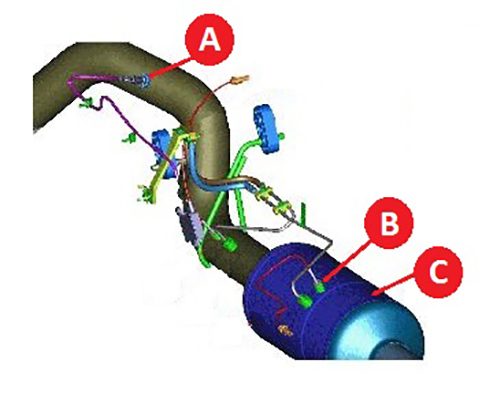LML displayed soot level as 'number of grams'
Those with monitors reported regen would start at about 42 grams.
Beginning with L5P, they number is called % soot and trigger at 100%
They also added a 'soot sensor'. (see diagram)
Regen at 100%
Keep driving at 115%
'Service regen required' fault will set at an 'undisclosed' level above that.
More regen info:
When to Perform a Diesel Service Regeneration – TechLink
When to Perform a Diesel Service Regeneration
December 31, 2017
A change was implemented recently in the values of the Diesel Particulate Filter (DPF) Soot Accumulation parameter displayed in GDS 2. On all 2016-2018 Colorado and Canyon models and 2017-2018 Express and Savana models equipped with the 2.8L Duramax diesel engine (RPO LWN) (Fig. 6, B); 2017-2018 Silverado and Sierra models equipped with the 6.6L Duramax diesel engine (RPO L5P) (Fig. 6, C); and 2017-2018 Cruze models equipped with the 1.6L diesel engine (RPO LH7) (Fig. 6, A), the DPF Soot Accumulation is measured in percent instead of grams.
Fig. 6
On these vehicles, the Engine Control Module (ECM) will not try to perform a regeneration until the DPF Soot Accumulation increases to approximately 100%. If the DPF Soot Accumulation increases to 115% and the system has not been able to regenerate due to driving conditions, a Continue Driving message will be displayed on the Driver Information Center (DIC). If the DPF Soot Accumulation increases above a calibrated percentage (based on diesel engine application), DTC P2463 (Diesel Particulate Filter Soot Accumulation) will set and a Service Regeneration will be required to clean the DPF.
As part of the emissions system, the DPF system includes an Exhaust Particulate Sensor (Fig. 7, A), an Exhaust Temperature Sensor (position 4) (Fig. 7, B), and the Diesel Particulate Filter (Fig. 7, C).
Fig. 7
Service Regeneration vs. Regeneration Enable and Drive Cycle
A Service Regeneration is designed to lower the soot accumulation in the DPF in a very controlled way. It is not as effective as a Regeneration Enable followed by driving the vehicle. A Service Regeneration should only be performed if the procedure is called out in the appropriate Service Information.
TIP: During a service regeneration, the vehicle will need to be parked outside the facility and away from nearby objects, such as other vehicles and buildings, due to the elevated exhaust gas temperature at the tail pipe during regeneration. The service regeneration can be terminated by applying the brake pedal, commanding service regeneration OFF using the scan tool, or disconnecting the scan tool from the vehicle.
If a vehicle has less than 70% DPF Soot Accumulation, do not perform a Service Regeneration unless instructed to by the Service Information. If there is a concern about the DPF Soot Accumulation, perform a Regeneration Enable and return the vehicle to the customer for a drive cycle.
TIP: If a vehicle with less than 500 miles (800 km) displays a Continue Driving message on the DIC, refer to #PIP5468 and Bulletin #10-06-05-002.
Converting Engine Hours to Mileage (km)
Fore vehicles that spend a lot of time idling, use the following formula to aid in determining the equivalent mileage (kilometers) for vehicle maintenance. This formula applies to diesel as well as gasoline engines.
- Check and record the total engine hours on the DIC.
- Multiply this time by 33 miles or 53 km.
- The result should be close to the mileage on the odometer.
For example, if a vehicle has 626.9 engine hours and 7,269 miles (11,698 km) on the odometer, the engine run time would equal about 20,688 miles (33,226 km).
626.9 x 33 miles = 20,688
626.9 x 53 km = 33,226
This vehicle would be considered a vehicle that idles a lot, which may be useful information when diagnosing any issues.
The engine hours formula should be used to aid in engine diagnosis only. It should not be used to determine any warranty claims.







